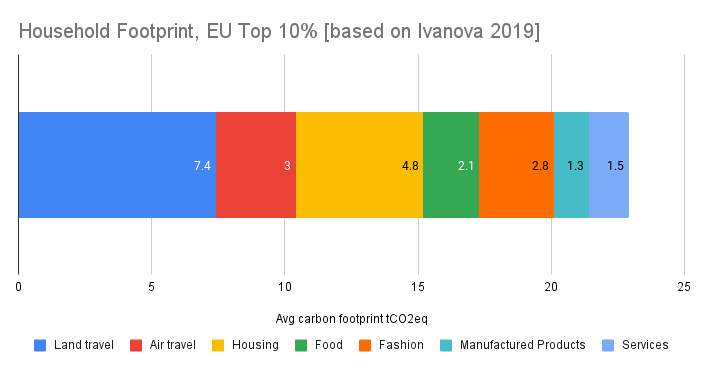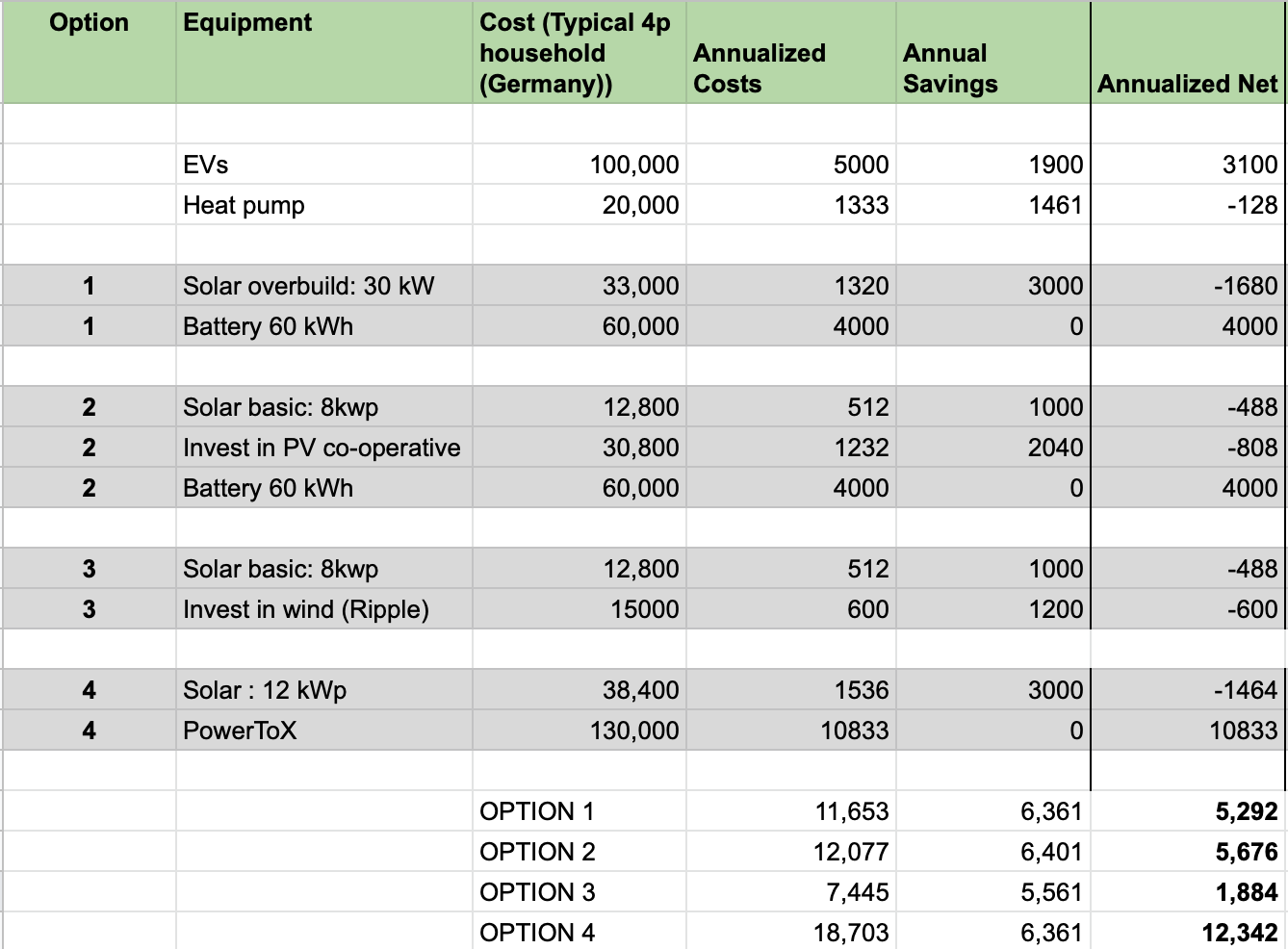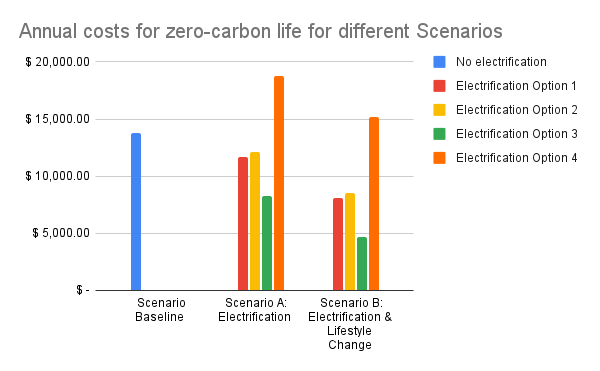Zero carbon living: what would it cost today?
In order to avoid the most significant impacts from climate change, warming has to be limited to 1.5°-2° Celsius. This could be achieved by decarbonising all human activities, including transport, energy, and food. It requires widespread cooperation to reach zero emissions globally, including the public sector, businesses, but also households. In fact, households are indirectly responsible for about 70% of global emissions.
There are two main ways individuals and households can get closer to a zero carbon life:
- Lifestyle changes (drive less, fly fless, eat less beef etc.)
- Switching to lower carbon products and services (such as renewable energy, EVs etc.)
Of course, the two can be combined in various ways, and the decarbonisation of products and services is also supported by policies and the (voluntary) action of businesses.
One important factor in this transition is, of course, cost. There have been calculations for the overall costs to society, but from an individual household perspective, it’s not immediately evident what such a transition would cost. For example, in the short term, some services may require capital investment (e.g. residential solar), but in the long run they may save money. Furthermore, some consumers may be willing to actively support new low-carbon products by being an early customer (Tesla being the prime example here).

We’ve been wondering what a true zero carbon lifestyle would cost today, and this is what we explore below.
The rules of the game
The naïve approach to a (net) zero carbon lifestyle would be to find the cheapest kind of carbon offsets, and simply offset one’s carbon footprint. Unfortunately, that wouldn’t solve the problem in the long run, so here we take an approach inspired by science-based targets: first reduce emissions, andremove only what can’t be reduced using proven carbon removal technology.
Detais on our constraints and rules for the exercise:
- We assume an average lifestyle without too many drastic changes. For example, we assume the average household may still drive a car.
- For any investments (car, heat pump, solar) for simplification, we ignore the manufacturing emissions, and focus on the emissions from use.
- For removal of remaining emissions we only “allow” technologies with high permanence and additionality, as qualified by CarbonPlan’s CDR database. These include technologies like Direct Air Capture and mineralisation etc.
What follows below is a back-of-the-envelope calculation with the intent to give some ballpark estimates and serve as a basis for discussion.
Footprint, reduction and cost for a zero carbon household
We base our typical household carbon footprint and its breakdown into categories on the work by Ivanova, 2019. For our analysis we assume a higher income EU household, which has an annual CO2 footprint of 22.9 tons. The breakdown into emissions categories for such a household looks as follows:

Naïve baseline scenario: pay for removal of all emissions
As a baseline scenario we can calculate the cost for removing all emissions using a carbon removal technology such as Charm Industrial’s, which converts biomass into a CO2-rich liquid that can be permanently stored underground Assuming EUR 600/t this would result in a baseline cost of EUR 13’740 annually for a zero carbon household.
Besides being expensive, this approach would also likely not work at scale, as it would require fast deployment of giant amounts of carbon removal infrastructure.
Scenario A: “electrify everything” (with zero carbon electricity)
Decarbonising life and the economy to a large degree boils down to decarbonising energy. The current consensus on how to do this is to
a) electrify everything
b) make electricity green.
If we consider our prototypical household mentioned above, the following categories can be electrified (and hence decarbonized) by consumers directly: home and (individual) land transportation.
This means:
- Switch to electric vehicles
- Heat home with a heat pump
- Put solar on the roof to get green electricity
- Install a battery to maximize one’s own solar consumption and to store electricity from low carbon intensity (oftentimes also inexpensive) electricity hours to high carbon intensity hours
In our scenario we assume a household in central Europe, for example Germany. The biggest challenge with electrification at that latitude is bridging the winter gap. One can rely on buying grid electricity through a green utility plan, however this electricity is usually purchased on an annual basis and “made green” through certificates (meaning: the grid electricity is still not zero carbon on a 24/7 basis). So we assume four possibilities to ensure really green electricity:
- Overbuild solar: build so much solar capacity that even in winter enough is produced. In practice most households won’t have enough roof or ground area to install the required amount of solar. By adding battery storage it might be still possible to do it at least in Southern and Central Germany (when latitude increases, the PV area and battery size needed for self-sufficiency also increases).
- A second option is to purchase additional solar capacity in a remote solar park.
- A third option is to complement solar with wind energy, which is typically most abundant in winter. For example, Ripple Energy in the UK allows consumers to buy shares in a wind park and “consume” the produced electricity.
- A fourth option is local seasonal electricity storage with hydrogen. This is the most “autark” but priciest solution. There are first commercial products appearing on the market (for example Picea) but the cost of these is largely inaccessible (at least for the people that live in areas where the winter gap with lack of sunshine is too long).
All of these transitions (EV, heat pump, solar) etc. result in an investment cost. In the below we list the investment costs, assuming a 4 person household in Germany. We then amortize the costs to get to an annual spending. We also deduct annual savings from the amortization costs, as most of the investments lead to savings (for example electricity for charging an EV is cheaper than gasoline etc.)

The annualized net costs for electrification are between approximately 2’000 and 6’000 Euro for Options 1 to 3. If we assume we continue to buy carbon removal for the activities we can’t electrify (air travel, food, consumption), electrification brings the total costs for a zero carbon household to 8’300 to 11’700 EUR annually, compared to 13’700 EUR in the naive baseline scenario with carbon removal for everything. It’s important to call out that electrification is actually cheaper than carbon removal.

Option 4, within-site seasonal hydrogen storage, costs 12’000 annualized for electrification, and results in a total annual cost of 18’000, i.e. significantly higher.
Detailed assumptions and parameters are listed in the footnotes of this post. (Contact us if you’re interested in getting access to the sheet for calculations).
Scenario B: electrification and lifestyle changes
The above activities did not yet lead to any change of lifestyle. If one is willing to carry the cost of carbon removal for activities that can’t be addressed by electrification or lower carbon product alternatives, they could maintain a similar life and already save over the naive baseline scenario.
However, if one would like to save costs and is willing to adopt lifestyle changes, the cost of a zero-carbon life could be further reduced by:
- Not flying (think going on vacation by EV or train, e.g. from Central Europe to Southern Europe). Assume no flights at all.
- Eating less meat: assume 20% reduction of emissions from food.
- Buy less fashion, products, services: we simply assume 20% reduction for consumption in each of these segments due to behavior changes.
These lifestyle changes reduce emissions, and costs now range from 4’700 to 8’500 Euro annually (with the hydrogen option coming in at 15’000), also shown in the figure above.
Discussion
In summary:
- Without lifestyle changes the costs for a true net zero carbon life based on electrification and carbon removal would land at about 600-1’000 Euro per month for an average household.
- Moderate lifestyle changes (20% reduction of food and consumption emissions, no air travel) would reduce this further to 400-700 Euro per month.
Additional autarky with on-site hydrogen storage has a significant additional cost.
While not low, these costs could certainly be handled by a “motivated” household. Note that the household carbon footprint we assumed for our calculation represents the top 10% of European households in terms of emissions. As household emissions correlate strongly with household income, our sample household should have sufficient income. It’s also important to keep in mind that the costs calculated are the costs based on today’s available and market-ready technology. Technological progress should push the costs further down significantly in the next decade or so.
The good news on consumption (fashion, products, services) is that companies in these sectors increasingly try to reduce their own footprints. By favoring emission-conscious, responsible brands, one can over time reduce or potentially almost eliminate emissions/ carbon capture costs from these segments.
Air travel and the food (meat) sectors are the most difficult to fully decarbonize and it may take a while until fully zero carbon options become available.
If your household is exploring options for a zero carbon lifestyle, we hope this analysis was useful for you in evaluating the range of possible scenarios. If you’d like to measure your household’s carbon emissions automatically and in real-time, and then learn how to reduce your emissions, download Zerofy in the iOS App Store.
Footnotes
[1] In Germany 2019, average household electricity consumption 3106 kWh - we assume that sources for this number are mostly dwellings without a heat pump but other type of heating https://www.destatis.de/DE/Themen/Gesellschaft-Umwelt/Umwelt/UGR/private-haushalte/Publikationen/Downloads/haushalte-umwelt-pdf-5851319.pdf?__blob=publicationFile
[2] For space heating + DHW it is 12501+2590=15091 kWh https://www.destatis.de/DE/Themen/Gesellschaft-Umwelt/Umwelt/UGR/private-haushalte/Publikationen/Downloads/haushalte-umwelt-pdf-5851319.pdf?__blob=publicationFile
[3] We assume that it is a fairly new house (at least has floor heating that increases the SPF) and therefore we take SPF=4.0 http://hpc2017.org/wp-content/uploads/2017/05/K.1.5.1-10-years-of-heat-pumps-monitoring-in-Germany.pdf Therefore the electricity need for heating is about 3975.25 We simplify and assume that the amount for heating is about the same as for the rest of the electricity consumption and double the PV+battery system. On the one most of this ca 4000 kwh is consumed during ca 6 months but on the other hand if the building is insulated the consumption might be two times lower (?). As the heat energy has certain inertia in building, then it is possible to shift the consumtion also within a day at least (to hours when solar is producing) and to install several hot water buffer tanks that cost much less than battery with the same energy storage capacity.
[4] From a comprehensive study, where PV+battery for self-sufficiency was modelled, we will take scenario S10 - approximate size of PV 15 kW and battery 10 kWh https://www.sciencedirect.com/science/article/pii/S0306261918309875. As in this study, they neglected heat energy needed, we will double these values as a simplified approach. Therefore we can conclude that in order to be self-sufficient in Middle-South Germany latitudes, a dwelling needs about 30 kW of solar panels at optimum angle and about 20 kWh battery
[5] Cars: we assume 4000kwh per year. 20k km with two cars, 200Wh/km incl charging los.
[6] Rooftop size : Average size Germany 100sqm, assume half covered (50), usable 40, means max 8wkp (200W/sqm)